Archie's 1960s super hero revival is considered by many fans to be the worst super hero comics of the 1960s. And of these, Archie's 1964 version of the Shadow has been called the worst of the worst.
I've heard every surviving episode of the Shadow radio program, watched most of the motion pictures and read the 1970s DC comic book. However, I haven't read a single Shadow pulp story and I know the pulps did most of the work in establishing who he was and what he could do. As I journey through Archie's the Shadow, I'll be reading these comics for the first time as the blog posts are written. Perhaps I'll conclude Archie's Shadow is underrated; perhaps it's a camp classic waiting to be rediscovered; perhaps it's as bad as its reputation claims. Let's find out together!
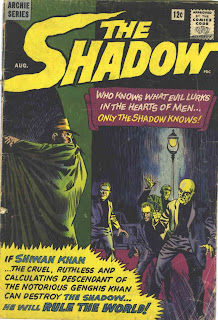
The cover of the Shadow#1 depicts the Shadow in his traditional clothing, albeit lit so his garb appears green. This is the version of the Shadow I'm familiar with, so let's crack this puppy open!

I won't be posting the entire issue, but I do think it's worthwhile to look at our title page: "the Shadow vs. the RXG Spymaster!!" It's 1961 and the Shadow is atop Notre Dame Cathedral with his enemy Khan (presumably Shiwan Khan, the villain in the Alec Baldwin Shadow movie - I understand he's from the pulps) closing in on him. The art isn't dynamic, but it's competent.
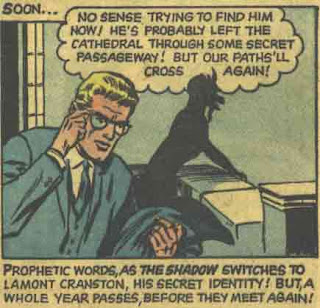
The Shadow's power is described as "ventriloquism" as he disorients Khan and his men by throwing his voice. He defeats Khan's henchmen, but Khan escapes with a smoke bomb. Strangely, the Shadow doesn't wear his hat or scarf in this encounter, exposing his face to Khan; when he goes back to being Lamont Cranston, he puts on glasses and takes off his cape. You call that a disguise?

One year later, Lamont is in his New York City town house with Margo Lane, a familiar face from virtually every version of the Shadow. Lamont's mail includes a letter from "the Society for the Preservation of American Bald Eagles" bearing an upside-down stamp; placing the letter in a special solution, Lamont exposes a secret message on the stamp: "Tuesday... noon! Feed pigeons in Bryant Park, behind New York Public Library!" Lamont says this is a message from Weston (Weston? Commissioner Weston, the police official from the radio?).
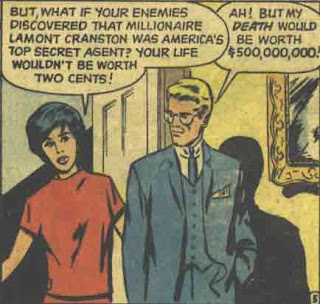
We quickly learn Lamont's home is protected with closed circuit cameras, which he uses to contact his chauffeur. Margo is worried about Lamont, but he reminds her he and Harry (who? the chauffeur?) are agents in the US Secret Service assisting the FBI, CIA & NATO and Weston is his CIA liaison. It seems in this version of the Shadow, Lamont is the world's most famous secret agent. The Shadow meets James Bond? It's not the worst idea. Anyway, Margo worries a single stray bullet could kill Lamont, but he claims he's "immune to peril!" In this version, Margo doesn't know Lamont is the Shadow, so I suppose his claims of being invulnerable leave her searching for a good psychiatrist.

Lamont leaves his town house in a Rolls Royce driven by Shrevy (the chauffeur from before), who's been a taxi driver in every version of the Shadow I know. After arranging for Shrevy to return later, Lamont is followed on foot to the library by two men in gray suits... say, Khan and his men wore gray suits. Lamont joins Weston on a park bench and they discuss Shiwan Khan, whom Lamont identifies as leader of "the world's most effective spy-for-hire organization!" He's also descended from Genghis Khan, as you might expect. Weston says Khan has been hired to steal plans for the RXG experimental plane for "an Iron Curtain country." The plans are in three sets and Weston gives their locations to Lamont.
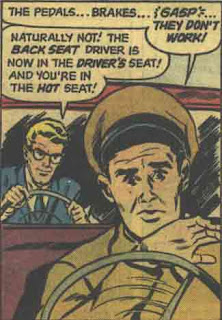
Lamont returns to his Rolls Royce, but Shrevy has been replaced by one of Khan's agents, who plans to seal Lamont within the back seat then flood it with gas! However, the car has a dual set of controls in the back seat and Lamont activates them, releasing a second steering wheel. He also sends an electric current through the front seat, stunning the driver unconscious. Lamont backseat drives to his town house and gets out of the Rolls Royce using an emergency release door. Removing his glasses and donning his cape, he becomes the Shadow!
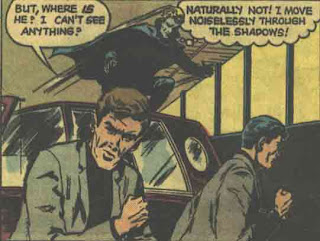
We now begin part two of the story: "the Shadow's Doom!" Through a monitor in the garage, the Shadow sees Margo is being held by Khan and his men elsewhere in the town house. Khan's men enter the darkened garage, only for the Shadow to shoot out the garage monitor so Khan can't see them, then shoot their guns from the agents' hands and finally defeat them using karate. The Shadow opens a secret passage to his office, following a rope ladder which descends from the ceiling. Climbing to the top, he shuts off the lights in the office, grabs Khan's last agent and throws him back down the passage.

Shiwan Khan recognizes Lamont's voice in the dark, which raises some questions about the purpose of the Shadow. Khan holds a gun to Margo so he can escape the office; he tells the Shadow another of his men is going to kill Weston. As Khan backs down the town house staircase, the Shadow throws a switch which turns the stairs into a ramp; as Khan & Margo fall, the Shadow changes back into Lamont Cranston to protect his identity. Um, he's not going to check and see if Margo broke her neck in the fall? Or that Khan's gun didn't go off in Margo's back when they slipped?

Khan exits the town house, vowing to settle accounts. After he leaves (for those keeping score, this is the second time Lamont has let Khan escape), Margo tells Lamont "they got Charley." Um, who's Charley? I still don't know who Harry is (is Shrevy's first name Charley? or Harry?)! Margo has also heard Khan reveal where he's hiding out. Lamont goes to his laboratory to contact Weston using a giant switchboard. By the time Lamont sends a radio message to warn Weston, Weston has already defeated Khan's agent. Lamont Cranson: master of timing! Lamont and Weston meet up near the George Washington Bridge and Lamont reveals Khan is staying at "Moody's Madness," an old ruined castle north of "Tarrytown." Weston wants to bring in the CIA, but Lamont says he's called in the Shadow to round up the mob. Weston is surprised, thinking the Shadow is "just a legend." Lamont stammers out a quick explanation, saying the Shadow takes assignments which are too dangerous for him. So, Lamont drives off alone to face Shiwan Khan. Not suspicious at all.

At the castle, one of Khan's men reports seeing "a shadow, creeping over the wall into the courtyard!" They activate infra-red searchlights, even as the Shadow's laugh emerges from the darkness; Khan recognizes the laugh, having heard it "once before." Come to think of it, the Shadow didn't use his laugh in the opening sequence, so I guess Khan heard the laugh prior to the fight atop Notre Dame. Khan's infra-red lights don't seem to assist them - they wind up shooting down a scarecrow wearing the Shadow's cape. The real Shadow appears and uses hypnotism on Khan and his men, "be-clouding" their memories of Cranston & Weston's operations.

When Weston arrives at the castle, he's met by Lamont, who shows him the inert Khan and his agents. Lamont explains the Shadow has "the power to be-cloud men's minds, a trick he learned in the Orient!" Wait, "be-cloud?" Weston doesn't find anything suspicious about this, instead suggesting the Shadow should do the same thing to the five men they've already caught. Weeks later, Weston & Cranston watch as the RXG goes on its test flight.
We've essentially got a reimagined version of the Shadow here - he's fighting Shiwan Khan for the first time, Weston doesn't know the Shadow, neither Shrevy nor Margo know who the Shadow is, and so forth. However, the series doesn't bother to explain who the Shadow is to the audience either, serving up a very different version of a potentially familiar character, but joining him in media res. And why is set in 1962, rather than present-day 1964?
I wonder if this comic was originally conceived of as a James Bond-esque super-spy comic, only to be reworked into a Shadow comic. The Shadow only wears his hat on the cover and seeing him represented as a fair-haired blond in a blue suit doesn't match any visual I ever entertained in my mind! Also, wouldn't an agent of the Secret Service be most concerned with President Kennedy's well-being, not going on missions with the FBI, CIA & NATO to protect secret plans?
The entire plot about the experimental plane is a wash; it's Chekov's gun, people - don't introduce the idea that the secret plans are in three hidden locations if we're never going to learn where those locations are. A better story would have raised the stakes by allowing Khan to obtain the list of locations, forcing Lamont to race against time to stop the theft. Instead we have Khan simply wandering away from Lamont's town house while our hero puts his glasses on - this does not communicate urgency! Khan is never allowed to be a competent villain because Lamont has a gadget (or scarecrow) ready for every contingency; even Khan's infra-red lights are worthless, with no explanation provided for how Cranston avoided them.
The Shadow/Lamont identity is pretty absurd here; Lamont is already known to be a secret agent by all of his enemies - why keep the Shadow as a separate identity? How is it Shiwan Khan can recognize Lamont's voice in the dark at one point, then recognize the Shadow's later yet not put two-and-two together? There no indication that Lamont's "Shadow" voice is different. And how could Weston possibly buy Lamont's lame explanation for involving the Shadow, then hear Lamont explain the Shadow's powers and origin without raising his suspicions? In the radio program, Lamont simply avoided talking about the Shadow around Weston and the Shadow communicated with Weston on his own behalf.
The Shadow's powers are barely explained; he has ventriloquism and he can "be-cloud" men's minds with hypnosis. He hides in the shadows, but it doesn't seem to be a supernatural power, he's just quite good at concealing his baby blue suit in the darkness.
According to the Grand Comics Database, this story was written by Robert Bernstein and drawn by John Rosenberger. I'm not familiar with Rosenberger, but Bernstein wrote a few early Marvel super hero comics in the 60s. The cover, by far my favourite thing so far, was drawn by Paul Reinman, a genuinely fine talent who'd been in comics since the 40s; he's best-remembered now as one of Jack Kirby's inkers in the 60s, but he was a great penciler in his own right.
There's a second story in this issue, but I'll cover it in the next installment of "Bitter Fruit." Anyway, we won't reach the supposedly very-awful stories until the Shadow#2, when we abruptly switch from super-spy to super-hero. Be there, or be-clouded!
...Say, who are Harry and Charley, anyway?


No comments:
Post a Comment